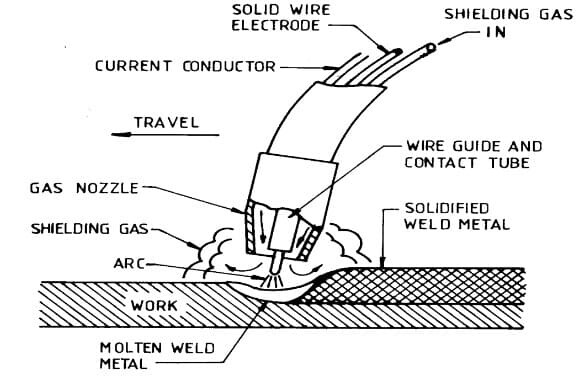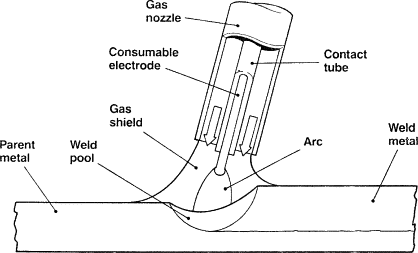In metal fabrication, welding is a fundamental process that binds metals together to create structures, machinery, and countless other essential items. Among the various welding techniques, Gas Metal Arc Welding (GMAW) and CO2 welding have emerged as popular choices due to their unique benefits and applications. This guide delves into the intricacies of these two welding processes, offering insights into their definitions, methods, advantages, and disadvantages. By the end of this article, you'll be well-equipped to decide which process aligns best with your specific welding needs.

I. What is GMAW Welding?

Gas Metal Arc Welding, commonly called GMAW or MIG (Metal Inert Gas) welding, is a widely used arc welding process. It utilizes a continuous wire electrode fed through a welding gun, creating an electric arc between the wire and the workpiece. This arc melts the wire, depositing metal into the joint to form a strong bond. The process is shielded by an inert gas, typically argon or a mixture of argon and carbon dioxide, which protects the weld area from atmospheric contaminants.
Primary Methods of Metal Transfer in GMAW welding :
Globular transfer: This method involves the formation of large droplets of molten metal that are transferred to the workpiece by gravity. It is suitable for thick materials and flat or horizontal positions, offering high heat input but resulting in significant spatter and low penetration.
Short-circuiting transfer: In this method, the molten metal forms small droplets that transfer to the workpiece by short-circuiting. It is ideal for thin materials and all positions, providing low heat input, minimal spatter, and high penetration.
Spray transfer: This method involves the formation of fine droplets that are propelled axially across the arc. It is best suited for medium to thick materials in flat or horizontal positions, offering high heat input, minimal spatter, and deep penetration.
Pulsed-spray transfer: This advanced method uses a pulsating current to transfer fine droplets across the arc. It is versatile, suitable for all positions and medium to thick materials, providing moderate heat input, low spatter, and consistent penetration.
To gain more knowledge of GMAW welding, you can read the article GMAW Welding (MIG) Basics: Definition, Types, Pros & Cons, Application. To know the top GMAW welding machine brand, you can visit the Top 10 GMAW Welding Machine Brands in the World (in 2023).
II. What is CO2 Welding?

CO2 welding, a subtype of Flux-Cored Arc Welding (FCAW), employs a tubular wire electrode filled with flux. When the electrode is heated, the flux melts and forms a protective slag over the weld pool, shielding it from atmospheric contamination. This process also introduces alloying elements to the weld metal, enhancing its mechanical properties.
CO2 welding specifically uses carbon dioxide as the shielding gas, offering good penetration, cost-effectiveness, and favorable mechanical properties of the weld. However, it also results in higher spatter, fumes, and oxidation compared to other shielding gases.
Types of FCAW Electrodes:
Self-Shielded Electrodes: These electrodes generate their shielding gas through the flux, eliminating the need for an external gas supply. They are convenient for field welding where external gas shielding is impractical.
Gas-Shielded Electrodes: These electrodes require an external shielding gas, such as carbon dioxide or a mixture of carbon dioxide and argon. They are typically used in controlled environments to produce high-quality welds with minimal slag.
III. Advantages and Disadvantages of GMAW vs. CO2 Welding
When deciding between GMAW and CO2 welding, it's crucial to evaluate several factors, including cost, weld quality, versatility, and automation capabilities. Below is a comprehensive comparison to guide your decision.
| Gas Metal Arc Welding (GMAW) | CO2 Welding |
Advantages | - High-Speed Welding: GMAW is a high-speed process, making it ideal for large-scale production.
- Clean Welds: The use of an inert shielding gas ensures minimal slag and spatter, resulting in clean welds.
- Versatility: GMAW welding can weld a wide range of materials, including steel, stainless steel, and aluminum.
- Low Hydrogen Levels: GMAW welding produces welds with low hydrogen content, reducing the risk of hydrogen-induced cracking.
- Easy Automation: GMAW welding can be easily integrated with robotic and automated welding systems for high-precision results.
| - Deep Penetration: CO2 welding offers deeper penetration, making it ideal for thick materials.
- High Deposition Rates: The process allows for high deposition rates, reducing the time required for large-scale welding projects.
- Cost-Effective: CO2 is a low-cost shielding gas compared to argon or helium.
- Outdoor Use: CO2 welding is less affected by wind and drafts, making it suitable for outdoor applications.
- Improved Mechanical Properties: The flux in the electrode adds alloying elements, improving the weld’s strength and durability.
|
Disadvantages | - High Equipment Costs: GMAW welding requires specialized equipment, including a welding gun, wire feeder, and shielding gas supply system.
- Shielding Gas Requirements: The process requires a stable shielding gas environment, making it unsuitable for outdoor or windy conditions.
- Skill Level: GMAW requires a skilled operator to achieve consistent results, especially in complex welding applications.
| - More Spatter and Fumes: CO2 welding produces more spatter and fumes compared to GMAW welding, requiring proper ventilation.
- Slag Removal: The protective slag must be removed after welding, adding an extra step to the process.
- Limited Material Compatibility: CO2 welding is primarily used for steel and may not be compatible with other materials like aluminum or stainless steel.
- Less Control: CO2 welding offers less control over the arc characteristics and weld quality compared to GMAW.
|
IV. Choosing the Right Process for Your Application
Selecting between GMAW and CO2 welding hinges on the specific requirements of your project. Below are some key considerations to guide your decision:
1. Material Compatibility
GMAW Welding: Ideal for welding stainless steel, aluminum, and thin carbon steel. Its adaptability to various materials makes it suitable for a broad range of applications.
CO2 Welding: Best suited for carbon steel and thicker materials. It excels in applications requiring deep penetration and high deposition rates.
2. Environmental Factors
GMAW Welding: Requires a controlled environment with minimal drafts to maintain the shielding gas effectiveness. Indoor welding setups are ideal for GMAW.
CO2 Welding: More adaptable to outdoor conditions and environments with airflow, making it suitable for fieldwork and large-scale projects.
3. Weld Appearance and Quality
GMAW Welding: Produces clean, visually appealing welds with minimal spatter, making it ideal for applications where aesthetics matter.
CO2 Welding: Results in welds with higher spatter and post-weld cleanup requirements, but offers superior penetration and strength in thick materials.
4. Production Efficiency
GMAW Welding: Offers high welding speeds and ease of automation, making it suitable for high-volume production environments.
CO2 Welding: Provides higher deposition rates and deeper penetration, advantageous for thick materials and heavy fabrication.
You can choose an ideal welding process based on the upper factors, or you can buy a multi-process welding machine based on the 7 Best Multi-Process Welders of 2023 – Reviews & Top Picks to meet your different welding process needs.
V. FAQs: GMAW and CO2 Welding
1. What materials are best suited for GMAW Welding?
GMAW is ideal for welding stainless steel, aluminum, and thin carbon steel.
2. Why is CO2 welding preferred for thick materials?
CO2 welding offers deeper penetration and higher deposition rates, making it suitable for thicker materials.
3. Can GMAW be used outdoors?
GMAW is less suitable for outdoor use due to its requirement for a stable shielding gas environment. CO2 welding is more adaptable to outdoor conditions.
4. Is CO2 welding more cost-effective?
CO2 welding can be more economical in terms of shielding gas costs, but the higher cost of electrodes may offset these savings depending on the application.
5. How does GMAW compare to CO2 welding in terms of automation?
GMAW is more easily adaptable to automation, offering better control over arc characteristics and weld quality.
Conclusion: Selecting the Optimal Welding Process
The choice between GMAW and CO2 welding depends on a variety of factors, including material type, thickness, environmental conditions, and desired weld quality. GMAW excels in producing clean, high-quality welds and is highly adaptable to automation, making it ideal for precision and high-volume applications. On the other hand, CO2 welding offers deeper penetration and higher deposition rates, making it suitable for thick materials and outdoor welding scenarios
To make the most out of your welding projects, consider investing in high-quality equipment from Megmeet Welding Technology. Their advanced GMAW and CO2 welding machines are designed to meet the demands of modern welding applications, ensuring superior performance and durability. Whether you're working on a small-scale project or a large industrial application, Megmeet Welders has the solutions to enhance your welding operations.
Related articles:
1. What is GMAW (MIG Welding) & How Does it Work?
2. Top 10 GMAW Welding Machine Brands in the World (in 2023)
3. Laser Welding Vs. Arc (TIG) Welding
4. Traditional Welding vs. Laser Welding
5. Manual Welding VS. Robot Welding






